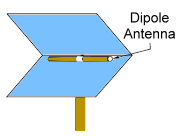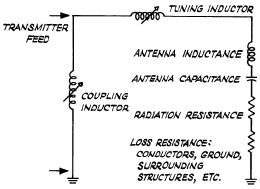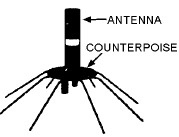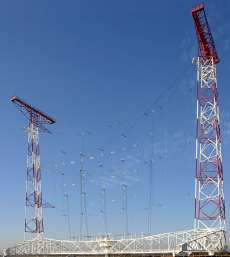Antenna Definitions
"A",
"B",
"C",
"D",
"E",
"F",
"G"/"H",
"I" to "L",
"M" to "O",
"P"/"Q",
"R",
"S",
"T",
"U" to "Z"
C to Cn, Co to Cz
Coaxial Antenna: A half-wave dipole antenna formed using a Coaxial Cable.
Coaxial Cable: A transmission line consisting of two conductors, one inside the other, and separated by insulating material. The inner conductor may be a small copper tube or wire; the outer conductor
may be metallic tubing or braid. Detailed Coax Cable definition and graphic. Radiation loss from this type of
line is less then other types of cable. [Coax Cable Manufacturers]
Collimation. The process by which a divergent or convergent beam of electromagnetic radiation is converted into a beam with the minimum divergence or convergence possible for that system (ideally, a bundle of parallel rays).
Collinear Antenna Array: An array of dipole antennas mounted in such a manner that every element of each antenna is in an extension, with respect to its long axis, of its counterparts in the other antennas in the array.
Communications circuit: The means by which information is transferred between two or more places.
Conductor: A material (usually metal) that has low resistance to the flow of electrical current. A wire, cable, or other object capable of carrying electric current. Good conductors are made of metals such as silver, copper, and aluminum.
Conical Monopole Antenna: A vertically polarized omnidirectional antenna used for broadband communications. A graphic resides on the monopole antenna page.
Connections: Points at which two or more conductors are brought
into contact. Also see a list of Connector Manufacturers [by type].
Corner-Reflector Antenna. A half-wave antenna with a reflector consisting of two flat metal surfaces meeting at an angle behind the radiator. A directional antenna using two mutually intersecting conducting flat surfaces. |  Corner-Reflector |
Counterpoise: A conductor or system of conductors used as a substitute for ground in an antenna system; a wire or group of wires mounted close to the ground, but insulated from ground, to form a low-impedance, high-capacitance path to ground.
Coupling. The desirable or undesirable transfer of energy from one medium, such as a metallic wire or an optical fiber, to another like medium. The diagram shows an equivalent circuit of an antenna coupler using resistors, capacitors and inductors. |  Equivalent Circuit |
Coupling Loss. The loss that occurs when energy is transferred from one circuit, circuit element, or medium to another.
Critical frequency: The highest frequency at which a signal may
be transmitted directly overhead and be reflected back to Earth from the ionosphere.
Cross-polarized: The polarization of a received signal is 90 degrees to the polarization of the receiving antenna.
Cross Modulation. A type of intermodulation of a desired carrier by undesired carriers.
Curtain Antenna: An antenna with elements that hang like a curtain [see the graphic to the right].










